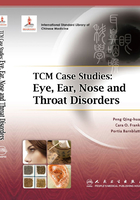
上QQ阅读APP看书,第一时间看更新
CASE STUDY
Female, age 27. Initial Visit: July 25, 2006
Chief Complaint: Recurrent dryness, pain and declined vision in the right eye for a year, aggravated for fve days with photophobia and tearing.
History: One year ago, the patient suffered from dryness, pain and declining vision in her right eye. She was diagnosed as herpes simplex keratitis. Her symptoms subsided afer being treated with antiviral eye drops. Aferward, this disease would recur when she was tired or had a cold. Five days ago, she caught a cold and sufered again from dryness, pain, photophobia, tearing along with a significant decline of vision in her right eye. She was treated with acyclovir eye drops, unsuccessfully and, in fact, her condition worsened.
Signs and Symptoms: Dryness, pain, photophobia, tearing and blurred vision in her right eye, with a slightly swollen eyelid, turbid hyperemia of the conjunctiva, starlike nebulae on the cornea, nasal congestion, a sore throat, a red tongue with a thin yellow coating, a rapid pulse.
Past History: Herpes simplex keratitis for one year.
Ophthalmologic Examination: Right eye vision 0.3, left eye vision 1.2. Slightly swollen eyelid of the right eye, mixed conjunctival hyperemia, a punctate opacity below the center of the cornea with fuorescein staining (+), clear aqueous humor, and sensitive pupillary light refex.
Pattern Differentiation
The cornea is associated with the wind wheel and belongs to the liver. Externally contracted wind-heat follows the trajectory of the liver channel and invades the cornea, resulting in a nebula. The nebula obstructs the path of light, leading to blurred vision. Wind-heat invades the eyes and causes blood stagnation in the collaterals of the eye, leading to turbid hyperemia of the conjunctiva, dryness, pain, tearing and photophobia. Wind-heat transforms into fire and attacks the upper body, resulting in nasal congestion and sore throat. The red tongue with a thin yellow coating and a foating rapid pulse are all signs of wind- heat.
The disease location is in the cornea and the patern is diferentiated as wind-heat invading the eye. It is an excessive patern.
Diagnosis
WM diagnosis: Herpes simplex keratitis (right eye)
TCM diagnosis: Clustered star nebula due to wind-heat invading the eye
Clinical Treatment
The clustered star nebula, redness and tearing were indications of wind-heat. Therefore, the treatment should focus on scatering wind and clearing heat, assisted by nebula-abating medicinals. Antiviral agents may be applied to the afected eye.
Principles: Scater wind, clear heat, remove nebula and improve vision
Formula: Modifed Yín Qiào Săn (Lonicera and Forsythia Powder)
[银翘散加减]

[Formula Analysis]
Jīng jiè, bò he, and niú bàng zĭ scatter wind and expel pathogens.
Jīn yín huā, lián qiào, dà qīng yè and dàn zhú yè clear heat, resolve toxins and vent the pathogens.
Chì sháo and zĭ căo cool the blood and remove the redness.
Mù zéi căo and chán tuì dispel wind, clear heat and remove nebula.
Prepared Medicines
Antiviral granules, 12-24g each time, 3 times a day.
Acupuncture
Points: BL 1 ( jīng míng), BL 2 ( cuán zhú), SJ 23 (sī zhú kōng), ST 2 ( sì bái), LI 4 ( hé gŭ), ST 36 ( zú sān lĭ), GB 37 ( guāng míng) BL 18 ( gān shù)
Method: Choose 2 local points and 2 distal points each time. Needle the points with drainage. Once daily.
Second Visit
Afer 20 days of treatment, pain, photophobia and tearing at the right eye were significantly relieved. Her eyesight improved, however, there was still dryness and visual fatigue in the right eye. Other signs and symptoms included dry mouth with no biter taste, slightly yellow urine, a red tongue with litle moisture, and a slightly rapid pulse. Examination showed right eye vision 1.0, slight ciliary hyperemia, and corneal opacity subsided with a smooth surface and fuorescein staining (-).
After the above treatment, although punctate opacities in the cornea subsided pathogenic heat was not completely cleared and there were signs of pathogenic heat impairing qi and yin.
Principles: Boost qi, nourish yin, clear heat and improve vision.
Formula: Zī Yīn Tuì Yì Tāng (Yin-Nourishing and Nebula-Abating Decoction)
[滋阴退翳汤]

[Formula Analysis]
Nü˘ zhēn zĭ, dì huáng, xuán shēn, mài dōng and zhī mŭ nourish yin and promote fuid production to moisten dryness.
Shān yào, huáng jīng and zhì gān căo fortify the spleen and boost qi.
Căo jué míng, qīng xiāng zĭ, jú huā and chán tuì enter the liver channel, clear heat and improve vision.
This formula focuses on reinforcing upright qi by boosting qi and nourishing yin, to prevent the disease from recurring.